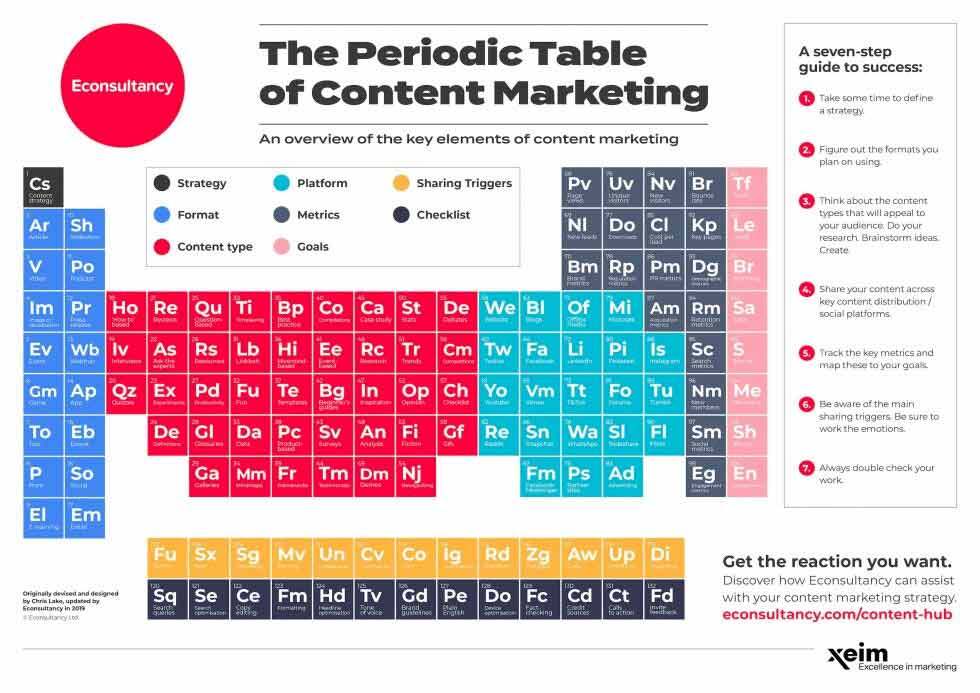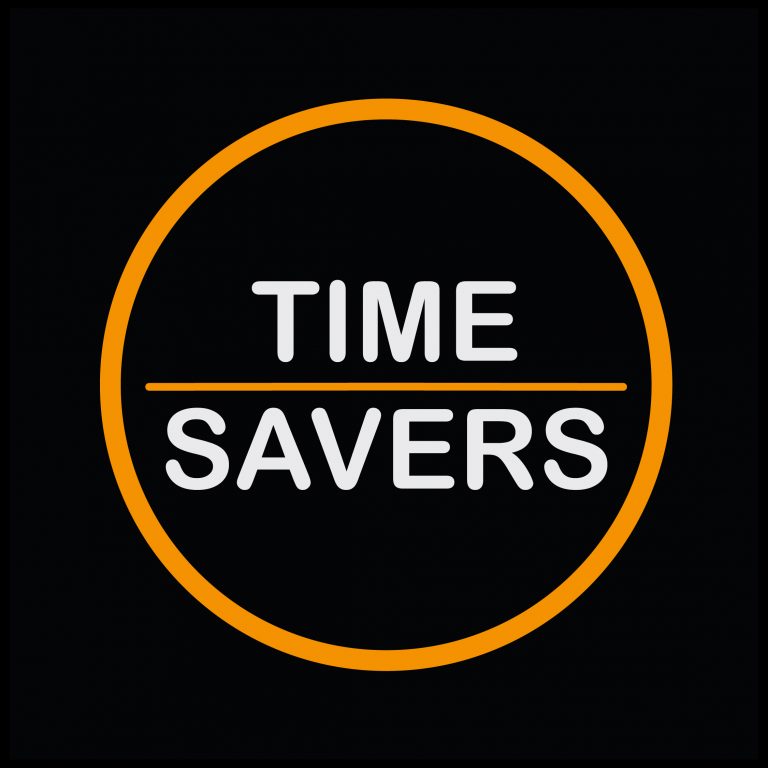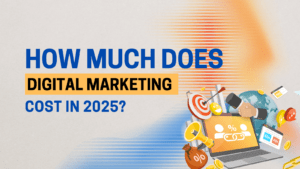Thankfully, the good people at Econsultancy have come up with this brilliant periodic table to help you to gain a better understanding of all the elements that are required when doing content marketing.
The table is divided into eight sections: Content Strategy, Format, Content-Type, Platform, Metrics, Goals, Sharing Triggers, and General Checklist.
Today, we’ll take a more in-depth look into what each of these sections is and why they matter.

Content Strategy
Content strategy is essentially your overall content marketing plan. Where do you see this entire process going, from your very first post to what the customer gives you?
When you set off to do a task, always have an idea of where you want the task to end up. For example, if your job is to go shopping, the end goal is to have a delicious, home-cooked meal that evening.
Without this particular element, none of the other parts will come together. How will you improve at content marketing if you don’t know what platforms you’ll be using or how to measure success?
Format
This is by what method your customers are going to consume the information.
Knowing the best form to use will set out the tone you want your brand to have, influenced by your clientele.
Some companies are geared towards a more casual audience, whereas others will be for professionals.
If you want to attract more leads, it’s vital you know what format your current leads would be most interested in using.
One example of a format is an article. These are a great middle-ground between casual and formal. The vast majority of people should be able to read them, despite still coming across as knowledgeable and professional.
Another format is the webinar. This type is brilliant for people with a keen interest in the area you specialise in. Similarly, for this audience, you could also try an app or eBook.
Content Type
Whilst we can forgive you for getting this one mixed up with format, there are some subtle differences between the two.
While format is all about how people look at your information, content type is like the subcategories of the formats.
The reasons for understanding what content types to use are similar to the reasons for understanding what formats to use. If you know your customer demographics, you can gain a better view of what they would enjoy.
One example of a content type is “how to,” an instructional article that explains how to accomplish something. The “how to” can be done as an article, video, infographic, or another format.
Content-type can also refer to the mood you wish to create; for example, your content type can be fun or emotional.
Platform
Platform refers to where your content’s location. What will people need to be using to see it?
Different platforms are used by different demographics. If you’re trying to appeal to the older generation, putting an ad in your local paper is likely going to gain a fair amount of interest.
If you’re targeting modern youth, using TikTok or Instagram may be a more appropriate platform.
Platforms can either be online or offline. Examples of online platforms include your website, blogs, and any social media platform. Offline platforms include newspapers/magazines, television, radio, posters, and billboards.
It’s extremely rare for any company to operate off of purely one platform. Many are on multiple social media sites, have their own website, and advertise offline, too.
The challenge is figuring out which platforms have the most amount of people who would be interested in what you specialise in.
Metrics
If I were to ask a group of people what they define as success, I’m sure that I would get a range of different answers.
No matter how you choose to measure success, make sure you know what you personally define as success and can measure it. This is known as “metrics”.
How do you know if you’re achieving your goals if you don’t measure anything?
There are many ways to measure success, and most of you will have more than one.
For example, you could measure it by “cost per lead”, the amount of money that it costs for each lead brought to you. You can also measure it by new members or new website visitors.
Plenty of brand metrics allow you to measure success too.
Goals
As mentioned right at the beginning, when you start doing something, it’s always beneficial to have an end goal in mind.
What’s the point in working for 12 hours a day if you don’t even know what you’re working for?
Goals give you something to reach for. They are closely related to metrics, but while metrics are measurements, goals tell you what you want to achieve.
One example of a goal is traffic. You may wish to increase traffic to your website by a certain amount in a certain time. Other goals include getting a certain number of leads, amount of sales, or a number of shares.
By establishing goals, you will know when you will have achieved success . And once you do, celebrate by throwing a staff party.
Sharing Triggers
As you can probably tell by the name, “sharing triggers” refers to what causes people to share your content.
By setting out your “sharing triggers”, you’ll have a better idea of what tone you wish your business to have, and you’ll also stand a better chance of actually meeting the goals that you’ve set.
Your sharing trigger could be funny. By creating a post that utilizes humour, people will laugh at it, and therefore be more likely to share that feeling with others.
You could also try being uplifting. Everyone likes to be inspired, and creating uplifting content encourages people to share their good mood with others.
General Checklist
The elements here are things you need to bear in mind if you wish to have a successful marketing campaign.
One element on the general checklist is SEO, search engine optimization. What have you done to make sure that your page is high on search results?
Another element is tone; how do you want your company to come across? When people think of you, should they feel happy, secure, interested? Knowing your desired tone will make the rest of content marketing much more straightforward.
Most B2C (business to customer) companies need to make sure everything they produce is written in plain English, free from techno mumble jumble, and written in a way that an average Joe will understand.
Why use the table?
Content marketing is a new but rapidly growing industry, and being able to navigate its complexity is vital to being able to survive in a 2020 market.
The idea of the periodic table of content marketing is to ensure you have a clear set of guidelines to do content marketing. What is the aim of your project? Where will you be publishing things? What format will you be using?
If you follow the pyramid, content marketing is going to be easier than starting from scratch.
Thumbnail Designed by Freepik.com















